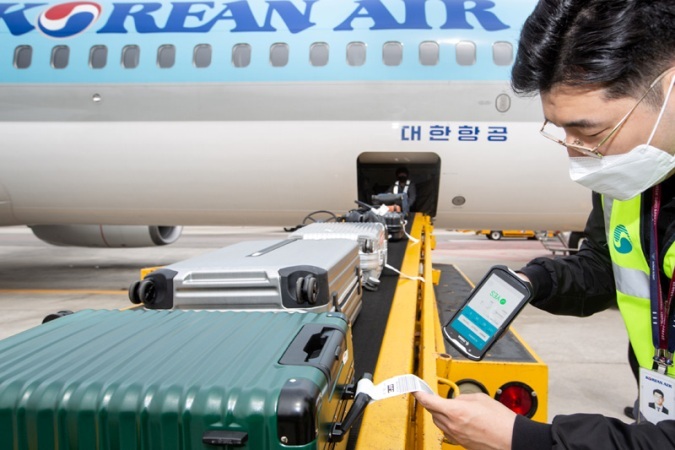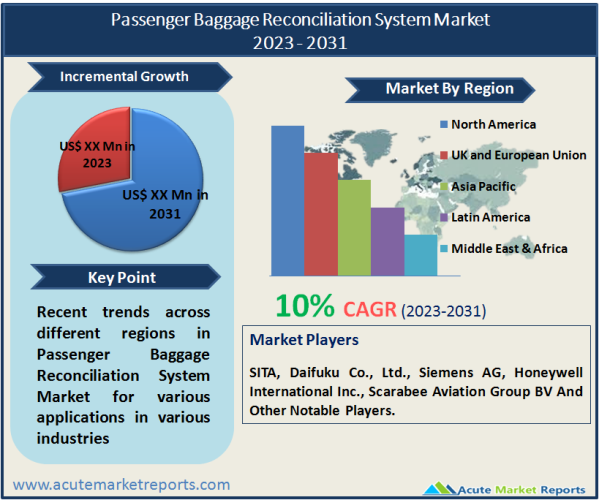
The passenger baggage reconciliation system market is expected to grow in the coming years due to the rising focus on ensuring passenger safety and enhancing the airport experience. The global passenger baggage reconciliation system market is expected to grow at a CAGR of 10% during the forecast period of 2025 to 2033. The passenger baggage reconciliation system is a software-based solution used to track passenger baggage throughout the airport journey, from check-in to baggage claim. The system ensures that baggage is accurately matched to its respective passenger, reducing the risk of mishandled bags and improving passenger satisfaction. The increasing number of air passengers and the need to manage and track their baggage efficiently are key factors driving the growth of the passenger baggage reconciliation system market. The International Air Transport Association (IATA) has set regulations for baggage tracking and handling, which has led to the adoption of passenger baggage reconciliation systems in airports worldwide. Overall, the growing need for passenger safety, enhanced airport experience, and efficient baggage handling are expected to drive the growth of the passenger baggage reconciliation system market in the coming years.

Increasing passenger traffic and air travel
Passenger traffic has been increasing rapidly in the last few years. According to the International Air Transport Association (IATA), the number of passengers traveling by air is expected to double by 2037, reaching 8.2 billion. This increasing demand for air travel has led to the need for more efficient and accurate baggage handling systems. The passenger baggage reconciliation system is a key component of baggage handling systems that ensures the correct baggage is loaded onto the correct flight, minimizing the risk of baggage mishandling and delays. The growing air travel demand is expected to drive the passenger baggage reconciliation system market growth in the forecast period.
Stringent government regulations
Government authorities across the world have implemented strict regulations regarding baggage handling and passenger safety. For instance, the International Civil Aviation Organization (ICAO) has set guidelines to ensure passenger and baggage safety. These regulations have mandated the use of automated baggage reconciliation systems, which can verify and reconcile baggage data before loading onto the aircraft. The passenger baggage reconciliation system market is expected to grow in response to the increased demand for regulatory compliance and enhanced passenger safety.
Advancements in technology
The advancements in technology have led to the development of advanced passenger baggage reconciliation systems that can handle a large volume of baggage efficiently. For instance, the integration of Radio Frequency Identification (RFID) technology into passenger baggage reconciliation systems has enabled airlines to track baggage in real time, ensuring the correct baggage is loaded onto the correct flight. Additionally, the implementation of Artificial Intelligence (AI) and Machine Learning (ML) in passenger baggage reconciliation systems has improved the accuracy of baggage handling and reduced the risk of baggage mishandling. These technological advancements are expected to fuel the growth of the passenger baggage reconciliation system market in the forecast period.
High Implementation Cost and Complexity
One of the major challenges faced by the passenger baggage reconciliation system market is the high implementation cost and complexity involved in the installation and integration of the system with the existing airport infrastructure. This is because the system involves the use of various technologies such as RFID, barcode scanning, and baggage handling systems, which require substantial investments in hardware, software, and skilled labor. Moreover, the integration of the system with the airport's existing IT infrastructure may require significant modifications and upgrades, which further increases the overall cost and complexity of the implementation process. For instance, according to a case study by SITA, the implementation of a baggage reconciliation system at Zurich Airport involved an investment of CHF 30 million, which included the installation of RFID readers, baggage handling systems, and the integration of the system with the airport's existing IT infrastructure. Thus, the high cost and complexity of implementing passenger baggage reconciliation systems act as a significant restraint for the growth of the market, especially for smaller airports and airlines with limited budgets.
Cloud-Based Systems to Promise Significant Opportunities during the Forecast Period
The type segment of the passenger baggage reconciliation system market is divided into cloud-based and local-based systems. The cloud-based segment is expected to grow at a higher CAGR during the forecast period of 2025 to 2033, owing to its advantages over the local-based systems. Cloud-based systems offer increased scalability, accessibility, and cost-effectiveness, which are driving their adoption in the industry. The global cloud-based baggage handling system market size is expected to grow at a CAGR of 12.5% during the forecast period of 2025 to 2033. The local-based segment held the largest revenue share of the market in 2024. The local-based systems, on the other hand, have been widely used in the past and are still preferred in some cases due to data security concerns. The local-based systems allow the data to be stored locally, which can prevent the data from being accessed by unauthorized persons.
Large Airports Leading Revenues, while Small Airports Lead the Growth
The passenger baggage reconciliation system market can be segmented based on its application in large airports and small airports. Large airports have a higher volume of passenger traffic and luggage to handle, making it more complex and time-consuming to reconcile passenger and baggage data. Thus, large airports held a higher revenue share in the market in 2024. According to a report by the International Air Transport Association (IATA), the total number of passengers traveling by air is expected to reach 8.2 billion by 2037, which will mainly be driven by emerging markets such as Asia-Pacific, the Middle East, and Africa. As a result, large airports in these regions are expected to experience significant growth in passenger traffic, leading to increased demand for passenger baggage reconciliation systems. The small airport segment, on the other hand, is expected to have a higher CAGR during the forecast period of 2025 to 2033, due to the increasing number of low-cost carriers and regional airlines. These airlines operate in smaller airports and are expected to adopt passenger baggage reconciliation systems to comply with regulations and enhance operational efficiency. Overall, the increasing demand for air travel and the need to comply with regulations are expected to drive the growth of the passenger baggage reconciliation system market in both large and small airports.
Asia Pacific to Emerge as the Global Leader
North America held the highest revenue share of the market in 2024, primarily due to the presence of major players in the region and the increasing investments in airport modernization projects. According to the Federal Aviation Administration (FAA), the number of air passengers in the United States is expected to increase from 880.5 million in 2019 to 1.28 billion in 2039, which is expected to drive the demand for efficient airport systems, including passenger baggage reconciliation systems. The region with the highest revenue percentage is expected to be Europe, primarily due to the presence of major players and the increasing investments in airport modernization projects in the region. However, the Asia-Pacific region is expected to hold the largest share of market revenues by the end of the forecast period due to the rising number of airports and passengers in countries like China and India. According to the International Air Transport Association (IATA), China is expected to become the largest aviation market by 2025, which is expected to drive the demand for passenger baggage reconciliation systems in the country. Furthermore, the Middle East and Africa region is expected to witness significant growth due to the increasing investments in airport infrastructure and modernization of airport systems. The European region is also expected to grow due to the rising demand for advanced airport systems to cater to the growing number of passengers. The region with the highest CAGR is expected to be the Asia-Pacific region, with a CAGR during the forecast period, due to the increasing demand for advanced airport systems and rising air passenger traffic.
Market Competition to Intensify during the Forecast Period
The global passenger baggage reconciliation system market is highly competitive, with several major players competing to capture a significant share of the market. Some of the key players in this market include SITA, Daifuku Co., Ltd., Siemens AG, Honeywell International Inc., and Scarabee Aviation Group BV, among others. These players are adopting various growth strategies such as partnerships, collaborations, and mergers and acquisitions to expand their market share and strengthen their position in the market. For instance, in 2019, SITA collaborated with Hamad International Airport to implement an advanced baggage management system that utilizes RFID technology to improve the tracking and handling of passenger baggage. Similarly, in 2020, Siemens AG acquired the baggage handling and logistics business of Invensys, a provider of airport solutions, to expand its presence in the airport industry. Furthermore, partnerships and collaborations with airport authorities and airlines are also playing a crucial role in the growth of the passenger baggage reconciliation system market. For example, in 2021, Scarabee Aviation Group BV partnered with Air France KLM to implement its baggage reconciliation system at Schiphol Airport in Amsterdam, Netherlands, to enhance the efficiency and accuracy of baggage handling operations. Overall, the passenger baggage reconciliation system market is expected to witness significant growth in the coming years, driven by the increasing demand for efficient and accurate baggage handling operations at airports worldwide. The major players in the market are expected to continue adopting growth strategies such as partnerships, collaborations, and mergers and acquisitions, as well as investing in research and development activities to introduce innovative solutions to the market and maintain their competitive edge.
Historical & Forecast Period
This study report represents analysis of each segment from 2023 to 2033 considering 2024 as the base year. Compounded Annual Growth Rate (CAGR) for each of the respective segments estimated for the forecast period of 2025 to 2033.
The current report comprises of quantitative market estimations for each micro market for every geographical region and qualitative market analysis such as micro and macro environment analysis, market trends, competitive intelligence, segment analysis, porters five force model, top winning strategies, top investment markets, emerging trends and technological analysis, case studies, strategic conclusions and recommendations and other key market insights.
Research Methodology
The complete research study was conducted in three phases, namely: secondary research, primary research, and expert panel review. key data point that enables the estimation of Passenger Baggage Reconciliation System market are as follows:
Market forecast was performed through proprietary software that analyzes various qualitative and quantitative factors. Growth rate and CAGR were estimated through intensive secondary and primary research. Data triangulation across various data points provides accuracy across various analyzed market segments in the report. Application of both top down and bottom-up approach for validation of market estimation assures logical, methodical and mathematical consistency of the quantitative data.
| ATTRIBUTE | DETAILS |
|---|---|
| Research Period | 2023-2033 |
| Base Year | 2024 |
| Forecast Period | 2025-2033 |
| Historical Year | 2023 |
| Unit | USD Million |
| Segmentation | |
Type
| |
Size Of The Airport
| |
|
Region Segment (2023-2033; US$ Million)
|
Key questions answered in this report